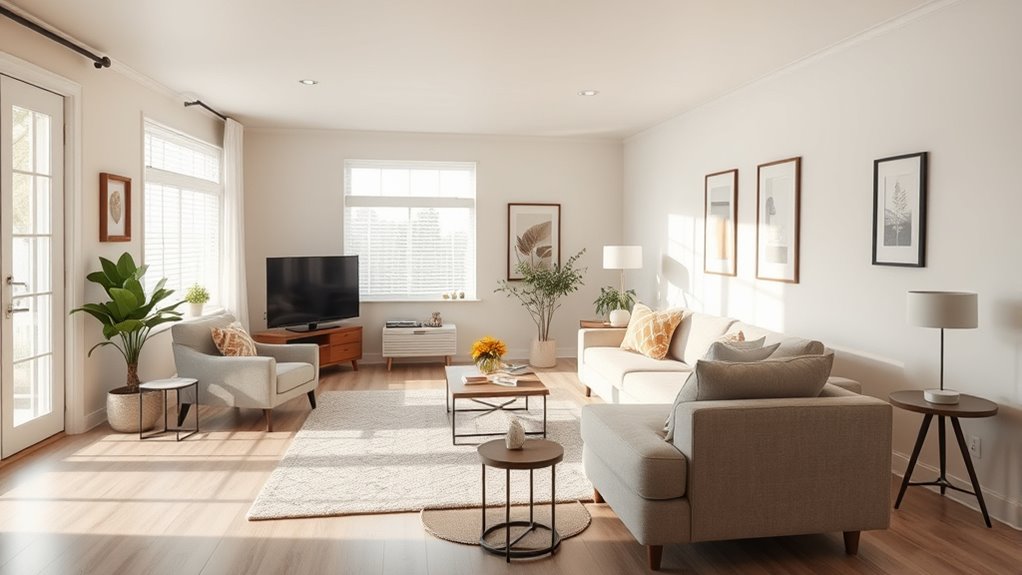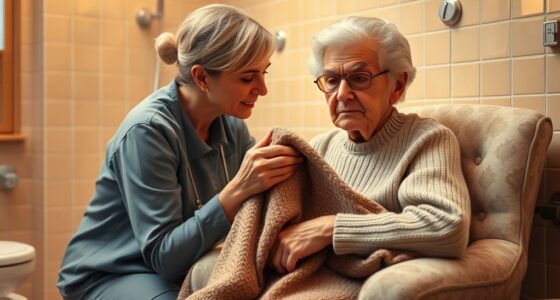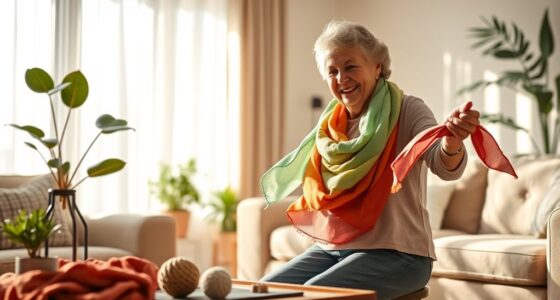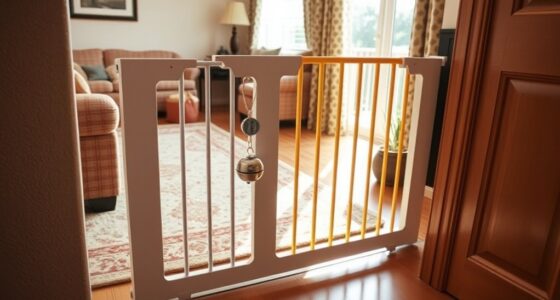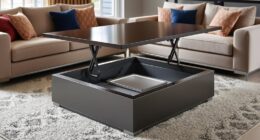To reduce Alzheimer’s triggers at home, create a safe, clutter-free environment with proper lighting that minimizes shadows and guarantees easy navigation. Make switches accessible and use nightlights for nighttime safety. Keep pathways clear and organize belongings in familiar, labeled spots to prevent confusion. Simplify rooms, maintain consistent placement of essentials, and secure rugs to prevent falls. If you want practical tips to make your home safer and more supportive, keep exploring how to design an environment that promotes independence.
Key Takeaways
- Implement bright, even lighting with nightlights to prevent falls and reduce confusion during nighttime.
- Simplify and organize the environment to minimize clutter, creating a calm, predictable space.
- Ensure easy access to switches and lighting controls with large, user-friendly devices.
- Keep pathways clear and obstacle-free, securing rugs and removing hazards to prevent trips.
- Maintain consistent placement of daily essentials to support independence and reduce frustration.
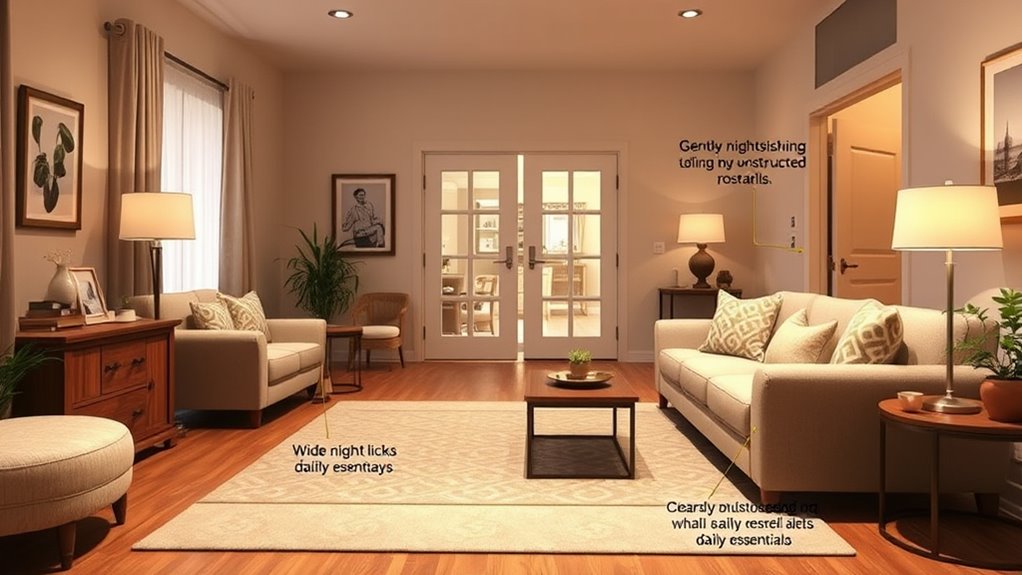
Creating a safe home environment is essential for reducing Alzheimer’s triggers and supporting your loved one’s independence. One of the most effective ways to do this is by paying close attention to lighting safety and clutter management. Proper lighting helps prevent falls and confusion, making the space easier to navigate. Bright, even lighting minimizes shadows and dark spots, which can cause disorientation or fear. Install bright ceiling lights in main areas like hallways, bathrooms, and staircases, and consider using nightlights to ensure safe movement at night. Avoid harsh, glaring lights that might cause discomfort or glare, which can increase confusion or agitation. Make sure switches are easily accessible, and consider using switches with large, easy-to-press buttons or touch lamps that can be operated without much effort. Good lighting reduces the risk of accidents and creates a calming environment, helping your loved one feel more secure and confident at home. Additionally, incorporating solar-powered lighting can provide reliable illumination without the need for complex wiring, enhancing safety during nighttime hours.
Clutter management is equally crucial in creating a safe space. Excess clutter can cause trips, falls, or confusion, especially for someone with Alzheimer’s. Regularly clear walkways, doorways, and staircases of unnecessary objects. Keep pathways wide and free of obstacles, and ensure rugs are secured with non-slip backing or removed altogether to prevent tripping hazards. Organize belongings in clearly labeled, easily accessible storage, so your loved one can find items without frustration or searching. Simplify the environment by reducing visual clutter, which can overwhelm someone with cognitive challenges. Use consistent placement for everyday essentials like keys, glasses, and medications, so they’re always in the same spot. This consistency decreases anxiety and helps maintain independence. When managing clutter, keep the environment calm and predictable, which supports a sense of order and safety.
Frequently Asked Questions
How Can Technology Assist in Creating a Safer Home for Alzheimer’s Patients?
You can use a smart home system to create a safer environment for Alzheimer’s patients by installing sensors and cameras that monitor their activity. These devices can send emergency alerts if someone wanders or needs help, allowing you to respond quickly. Smart locks and door alarms also prevent accidental exits, providing peace of mind. Technology helps you stay connected and proactive in ensuring your loved one’s safety around the clock.
What Are Cost-Effective Modifications for an Alzheimer’s-Friendly Home?
Think of your home as a fortress, and budget modifications as your secret weapons. You can easily implement DIY safety upgrades like adding clear, contrasting tape to steps, securing rugs, and installing simple locks. These cost-effective changes don’t need to break the bank; they create a safer environment for your loved one. With a little effort, you turn your home into a protective sanctuary that minimizes risks and promotes independence.
How Do Cultural Differences Influence Home Safety Design for Alzheimer’s?
Cultural differences shape home safety design by influencing norms around privacy, independence, and family roles. You should consider cultural norms to create a comfortable environment and involve family members in safety planning, guaranteeing everyone understands and supports safety measures. Incorporate culturally appropriate signage or symbols, and adapt safety devices to respect traditions. Family involvement is essential, as it fosters trust and ensures safety strategies align with cultural values.
Are There Specific Safety Considerations for Outdoor Spaces?
You might think outdoor spaces are safe, but they need specific considerations. To improve garden security, install secure fencing and locks on gates, and remove tripping hazards. Use outdoor lighting to enhance visibility at night, reducing fall risks. Consider adding clear pathways and avoiding confusing signage. These steps help create a safe, accessible environment that minimizes triggers and guarantees peace of mind for someone with Alzheimer’s.
How Often Should Home Safety Assessments Be Updated?
You should update your home safety assessment at least once a year, or more often if there are changes in your loved one’s condition or environment. Regular assessments help you identify new hazards and ensure safety measures stay effective. Staying proactive with your home safety checks allows you to adapt quickly, reducing risks and creating a secure, comfortable space that supports independence and peace of mind.
Conclusion
Creating a safe home tailored to reduce Alzheimer’s triggers helps you enjoy peace of mind and independence longer. By making simple adjustments, you’ll prevent accidents and reduce stress for both you and your loved ones. Remember, a stitch in time saves nine—investing in safety today guarantees a brighter, safer tomorrow. Embrace these changes with confidence, knowing you’re actively protecting your well-being and maintaining your quality of life every step of the way.
